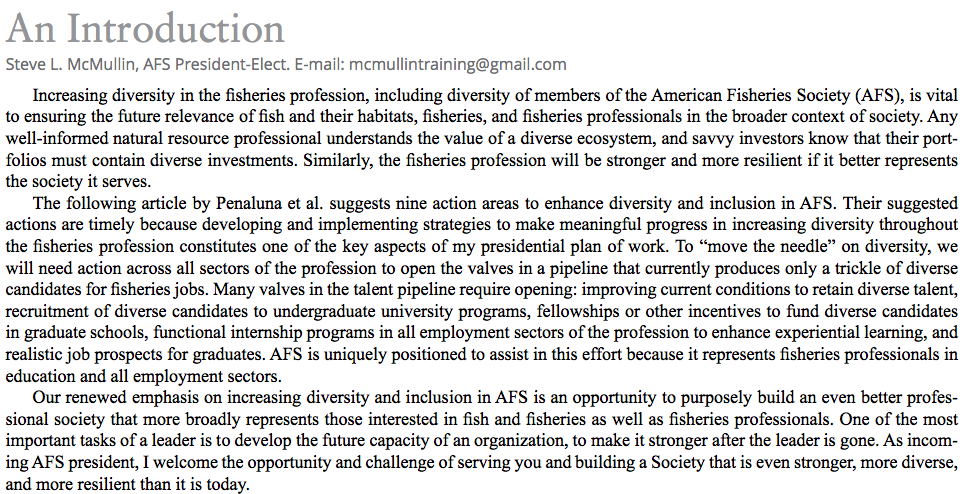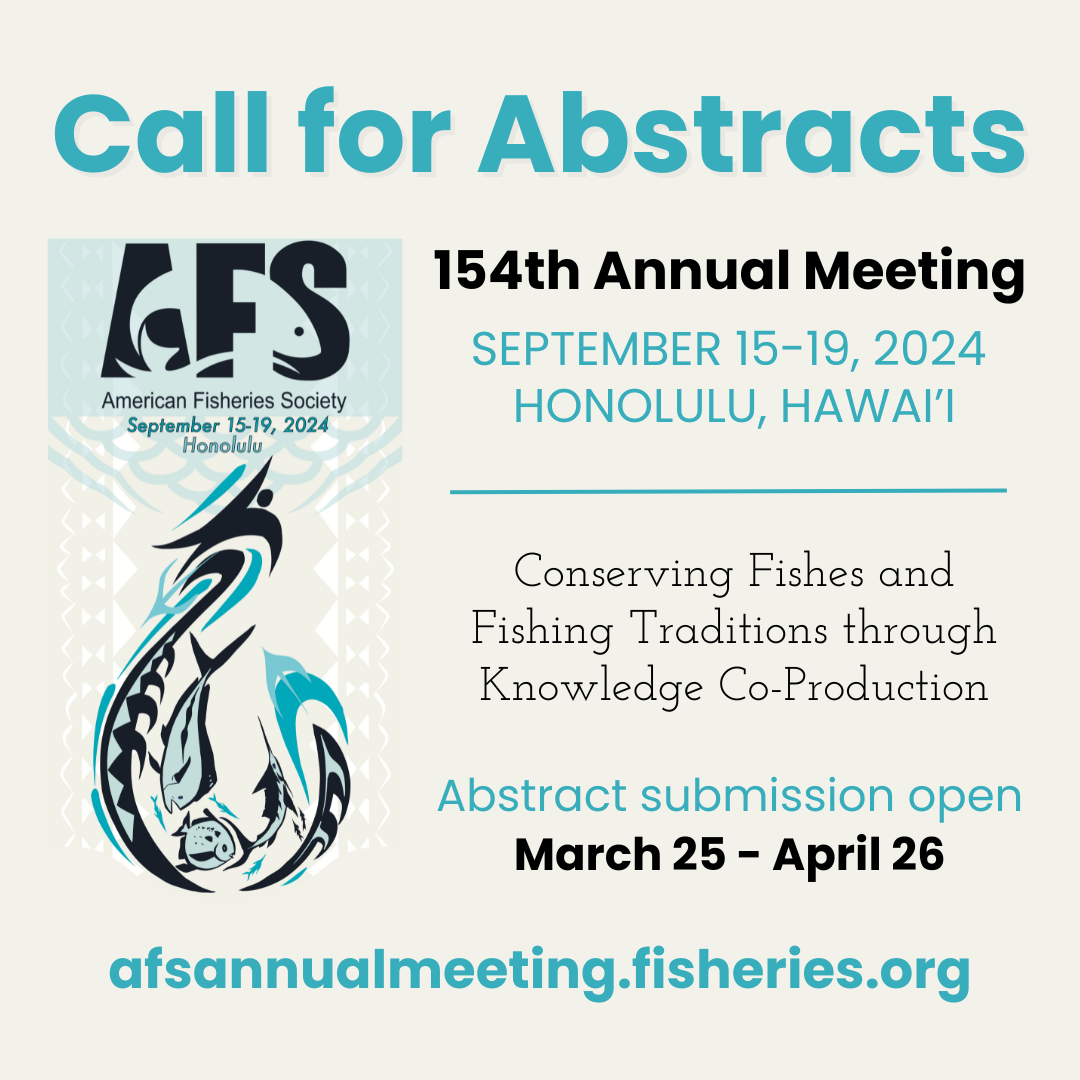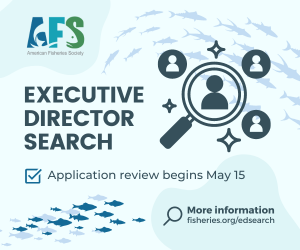Brooke E. Penaluna, U.S. Department of Agriculture Forest Service, Paci c Northwest Research Station, 3200 SW Je erson Way, Corvallis, OR 97331. E-mail: [email protected]
Ivan Arismendi, Department of Fisheries and Wildlife, Oregon State University, Corvallis, OR
Christine M. Mo tt, Idaho Cooperative Fish and Wildlife Research Unit, Department of Fish and Wildlife Sciences, University of Idaho, Moscow, ID
Zachary L. Penney, Columbia River Inter-Tribal Fish Commission, Portland, OR
As the world’s oldest and largest organization dedicated to the fisheries profession, the American Fisheries Society (AFS) has a unique opportunity to be an active agent of change for the fisheries community by diversifying its membership to prepare future leaders in the fisheries workforce worldwide. Every five years, AFS appoints a special committee to review and update a strategic plan that includes focused goals in set areas and strategies to achieve those goals. In the 2015–2019 plan, there are strategies aimed at addressing diversity and inclusion, specifically to “enhance participation of students and professionals at all levels of the Society to assure member recruitment, retention, and leadership development into the future and to promote ethnic, socio-economic, generational, and disciplinary diversity within the Society and the fisheries profession” (https://fisheries.org/about/governance/strategic-plan-2015-2019/). There is recognition that “the Society will increase the disciplinary, gender, ethnic, and cultural diversity and engagement of its members as a vital means to maintain relevancy and respond to the challenges facing fisheries science and management” (https://fisheries.org/about/governance/strategic-plan-2015-2019/).
Progress, however, toward changing the face of AFS and the fisheries workforce at large has been slow (Figure 1). Over the past 2 decades, the proportion of women members in AFS has increased from 9% to 25% and its non-white membership has gone from 5.5% to 8% (Eva Przygodzki, AFS, personal communication). The lack of diversity and inclusion is an issue that affects the broader fisheries community. A recent study by Arismendi and Penaluna (2016) shows that only 26% of federal fisheries scientist/manager positions and less than 30% of tenure-track professor positions are currently occupied by women. In addition, non-white fisheries scientist/managers occupy less than 12% of positions in federal agencies and tenure-track professors. Scientific manuscripts submitted to fisheries journals with women as first authors are significantly less likely to be published than those with men as first authors by 4% (Handley et al. 2015). More broadly, across organizations in the environmental sector, including natural resources, the Green 2.0 report has identified a need to be more deliberate about issues facing diverse talent and their inclusion (Taylor 2014; Beasley 2016). Here, we propose actions that would promote more intentional advances toward diversity and inclusion in AFS. Ultimately, diversifying the membership of AFS brings multiple perspectives to the table, based on different cultures and life experiences, which not only helps keep the Society relevant, but allows us to respond more broadly and deeply to the challenges facing our world’s fish and fisheries.
Figure 1. (A) Gender and (B) race/ethnicity composition of AFS membership in 2015. We included comparable data from the Ecological Society of America (ESA) in 2015, science, technology, engineering, and mathematics workforce in 2013, and U.S. population census from 2010. Percentages are estimated based on voluntary responses of members for AFS (total membership includes 7,870) and ESA (total membership includes 8,951). Similar data from other professional societies including the Society of Wetland Scientists (Vanessa Lougheed, personal communication) and Society of Range Management (Jess Peterson, personal communication) were not available. The Society for Freshwater Science collects other categories of information, including birth year, education, employment, and categories such as taxa group, habitat, and areas of interest, but not gender or race/ethnicity (Joy Brisighella, personal communication). Sources: AFS data from Eva Przygodzki (AFS, personal communication); ESA data from 2016 Annual Report to Governing Council (ESA 2016); and science, technology, engineering, and mathematics workforce data from the National Science Foundation (2015).
Changes to increase diversity and inclusion are necessary for progress in fisheries, but it can be hard to discern how to implement them, especially in an organization as large and geographically expansive as AFS. It is recognized that increasing the diversity of any organization provides many tangible and intangible benefits, including more innovation, better problem solving (Ostergaard et al. 2011), increased productivity (Horta 2013), and higher impact science (Freeman and Huang 2015). Fisheries involves not only working with diverse groups of people and stakeholders, but also a diverse array of fisheries resources. Organizations that are well networked, through multitiered organizational structures such as AFS, have the opportunity to enhance mutual understanding if they communicate and engage at all levels. Hence, diversity and inclusion issues can be effectively addressed if they are simultaneously considered at multiple levels of our Society.
A common challenge in addressing issues related to diversity is the recognition of biases inherent in the way each of us receives and processes information. “Unconscious bias” refers to the favorable or unfavorable attitudes or stereotypes that affect the unconscious assessment of others, often leading to unintended consequences. Such biases are automatic and are generally tied to identity-based characteristics, such as race/ethnicity, gender, sexual orientation, age, country of origin, and physical ability. If the Society can address biases, then it is helping to create an environment where all participants, whether among the majority, minority, or somewhere in between, are valued and feel equally welcome. Many professional societies unknowingly have “prototypes for success” that perpetuate a similarity bias and limit the pool of potential candidates for positions and promotions. Systematic removal of barriers to the inclusion and promotion of diverse talent from historically underrepresented groups at all levels in AFS is warranted. Eliminating disparities begins with conversations about biases among members of the Society (Singleton 2015), such as where did these biases come from, why are they still here, and how do we change them for the better?
In symposia, panels, and personal interactions, many members have articulated that AFS could improve on ways to connect efforts of diversity and inclusion to other members at all levels within the society and to the broader fisheries community. We hope to continue that discussion here by highlighting a number of actions to support deliberate advances toward diversity and inclusion in AFS and we integrate a few examples of current and past efforts (Figure 2). We focus on nine action areas, with suggestions on how structures and processes might be improved to break obstacles and biases leading to real increases in diversity and inclusion.
-
Entrench diversity and inclusion as core value of AFS. As AFS strengthens its commitment to diversity and inclusion, this core value should be central within the vision and goals of the Society and paired with a diversity statement. Gains in diversity and inclusion have the potential to erode over time if advocates of inclusion move on and their legacies fade. AFS could lead the way in educating our own fisheries professionals on how improving diversity and inclusion could help us better address global and regional challenges in fisheries science. The new Diversity Joint Venture, in which AFS is a partner, includes agencies, nongovernmental organizations, and other organizations and is a tremendous step forward in this direction.
-
Undertake self-reflection and evaluation. Implicit association tests are useful to identify unconscious biases and to help us bypass the automatic assumptions that occur in our brains as we make decisions. Biases can lead to missed opportunities and the exclusion of some individuals or groups that use and depend on fisheries resources. For example, who do we listen to, who do we consider an expert, are everyone’s ideas being heard respectfully, how qualified do we think someone is for a position, and do we think their qualifications are ideal? To overcome biases, individuals can readjust their roles and participation to support an inclusive environment for all fisheries professionals. Colleagues can build awareness of the scientific contributions made by women and/or colleagues from underrepresented groups and they can accept invitations to speak at events or on expert panels only if women and/or colleagues from underrepresented groups are also represented.
-
Identify and eliminate structural biases. Biased decisions are generally not made to be malicious; rather, they occur unintentionally to help us make quick, comfortable decisions. But, if and when biases are part of the organizational structure, then the exclusion of some individuals or groups that use and depend on fisheries resources is systematically occurring. Leadership and selection committees can offer consistent and clearly written criteria for awards/selection/promotion. AFS can form work groups with diverse membership to identify structural biases that exist in leadership, organizational structure, and meeting planning. For example, do leaders and committees in AFS represent individuals and groups that use and depend on fisheries in your region? If not, how can we change this?
-
Promote diverse talent into leadership roles and prepare leaders to be agents of change. AFS can provide professional development opportunities to improve performance and to identify and build future fisheries leaders. By promoting inclusion across all levels of AFS including leaders, members, committees, and staff, the process can start at the top. Bringing members of underrepresented groups into leadership positions requires proactive engagement by everyone to overcome fears, habit, inertia, and resistance. Leaders can actively discuss and promote the importance of diversity and set the agenda for the Society. Leaders and members can promote constructive discourse and honor other people’s opinions. Inviting diverse talent to key collaborations, meetings, and outings will help them join networking events, so they can be seen as potential leaders. Increasing awards to and recognition of members who support the recruitment, retention, and promotion of a diverse professional environment can also be helpful.
-
Develop targeted sessions on communication, inclusion, and recognition of unconscious bias at AFS meetings. Increasing the visibility and frequency of sessions related to communication about diversity and inclusion topics, identification of unconscious bias, and communicating with diverse audiences can be helpful. Such sessions provide training and skills to navigate what can be uncomfortable conversations around race/ethnicity, gender, sexual orientation, age, country of origin, and/or physical ability. For example, the Oregon Chapter meeting theme for 2017 was “Casting a Broader Net: Increasing Diversity and Inclusion in the Fisheries Profession,” with a symposium dedicated to the topic. As another example, the Equal Opportunity Section has sponsored many panels and symposia to discuss programs and opportunities for inclusion. The two most recent events were held at the AFS Annual Meetings in Portland, Oregon (2015), and Kansas City, Missouri (2016), which brought together a wide range of AFS members from various levels of the Society (Figure 3). In 2017, a free workshop devoted to addressing unintentional bias in the fisheries profession will be provided at the Tampa, Florida, meeting. Education and awareness are key components of improving the professional culture of AFS for current and future members and building a platform for continued discussions. Many of these discussions may also continue at luncheons and receptions that allow for open discussions of member concerns and ideas.
-
Highlight family-friendly opportunities at AFS meetings. AFS has provided opportunities for family-friendly meetings, but the process is not institutionalized in local, state, division, and international meeting structures. Consider increasing the visibility and opportunity for daycare and family rooms at AFS meetings, so that fisheries professionals will not have to choose between their families and career development.
-
Incorporate diversity and inclusion in fisheries pipelines and programs, and at meetings. Strengthen relationships with colleges and universities, heritage-based groups, minority-serving institutions, and tribal and indigenous organizations. Recruiting students for fisheries positions from organizations that promote underrepresented groups in science, such as Advancing Chicanos/Hispanics and Native Americans in Science, may help. The Hutton Junior Fisheries Biology Program has been a successful summer intern program offered through AFS to recruit diverse talent at the high school level, primarily from underrepresented groups, into the field of fisheries by linking them with members. Opportunities for reverse mentoring, the buddy system, or coaching where expertise from both emerging leaders and experienced fisheries professionals is valued will build community. Social events with themes that emphasize cultural diversity can be organized. Interactions with the International Fisheries Section and AFS members in other countries (e.g., Mexico Chapter) can also elevate understanding of their programs within the Society. Although there is the Emmeline Moore Prize administered by the Equal Opportunity Section, which is is a career achievement award recognizing a member who has provided a strong commitment and exemplary service to the promotion of demographic diversity in the society, fewer women and individuals from underrepresented groups are nominated for awards or receive AFS awards overall. By creating a local climate where everyone is welcome, AFS will fully realize the benefits of diversity by retaining diverse talent.
-
Develop a diversity and inclusion scorecard for AFS and the fisheries workforce. If “advancing and promoting fisheries, aquaculture, and aquatic science” is the primary science goal of AFS, then to achieve this goal AFS members must structure and maintain an inclusive climate. Multiple metrics from demographic information of our members and participants can be used to evaluate status and progress over time. Institutionalized methods for evaluating status and progress on diversity and inclusion can be helpful in sustaining commitment to diversity as a core value and building trust and transparency in communication among members. Although reporting is voluntary, displaying the scorecard annually at meetings may provide an incentive for members to report information because they will see the utility in the data. Collection and presentation of the data at the local or regional level addresses the diversity problem at the root, and the direction and urgency can continue to come from AFS leadership. The Society already has a membership category for young professionals and recognizes outstanding emerging leaders, including the J Frances Allen Scholarship for a promising female Ph.D. candidate. In addition to metrics given in the AFS strategic plan, there are other possible metrics, including number of AFS members, plenary speakers, symposium organizers, award nominees and awardees, or Governing Board leaders who are women or from underrepresented groups.
-
Establish equal opportunity committees within AFS units. Although many divisions, chapters, or sections of AFS have established significant efforts to support, mentor, and train students and early career professionals in AFS, some AFS chapters could gain momentum on this topic by creating committees or working groups concerned with diversity and inclusion and equal opportunities.
In conclusion, just like the fishes that we study, the resilience and adaptability of the fisheries profession is dependent on a robust and diverse conglomerate of fisheries professionals. Resilience in ecological systems relies on the variety of functional groups and their adaptive capacity (Gunderson 2000). We see this same dynamic existing within the fisheries profession: For the ecosystem to function at the highest level, every component is important. Ultimately, benefits of increasing the diversity of members in AFS depend on each of us helping to expand our demographic profile to include more women and underrepresented groups and to provide an inclusive environment for everyone.
ACKNOWLEDGMENTS
We thank current and past members of AFS for their efforts and achievements enhancing diversity, inclusion, and equal opportunities. This essay was encouraged by Bob Hughes and Jeff Schaeffer. Donna Parrish, Doug Austen, Michael Donaldson, Bob Hughes, Julie Claussen, and two anonymous reviewers provided helpful comments. Kathryn Ronnenberg prepared figures. Use of trade or firm names here is for reader information only and does not constitute endorsement of any product or service by the U.S. Government.









